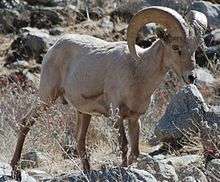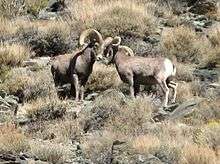Desert bighorn sheep
| Desert bighorn sheep | |
|---|---|
 | |
| Scientific classification | |
| Kingdom: | Animalia |
| Phylum: | Chordata |
| Class: | Mammalia |
| Order: | Artiodactyla |
| Family: | Bovidae |
| Subfamily: | Caprinae |
| Genus: | Ovis |
| Species: | O. canadensis |
| Subspecies: | O. c. nelsoni |
| Trinomial name | |
| Ovis canadensis nelsoni Merriam, 1897 | |
Desert bighorn sheep (Ovis canadensis nelsoni) is a subspecies of bighorn sheep (Ovis canadensis), that is native to the deserts of the Southwestern United States and Northwestern Mexico.
The trinomial of this species commemorates the American naturalist Edward William Nelson (1855–1934). The characteristics and behavior of desert bighorn sheep generally follow those of other bighorn sheep, except for adaptation to the lack of water in the desert. They can go for extended periods of time without drinking water.
Distribution
The range of Desert bighorn sheep includes habitats in the Mojave Desert, Colorado Desert, and Sonoran Desert. Anza-Borrego Desert State Park, Joshua Tree National Park, Death Valley National Park, Kofa National Wildlife Refuge, Cabeza Prieta National Wildlife Refuge, and Mojave National Preserve all offer protected habitat for this animal.
Populations of the desert bighorn sheep declined drastically with European colonization of the American Southwest beginning in the 16th century. These declines were followed by a period of population stabilization ascribed to conservation measures.[2] As of 2004, desert bighorn sheep numbers remain extremely low, although the overall population trend has increased since 1960.[2]
Characteristics
Desert bighorn sheep are stocky, heavy-bodied sheep, similar in size to mule deer. Weights of mature rams range from 115 to 280 pounds (55 to 90 kg), while ewes are somewhat smaller. Due to their unique concave elastic hooves,[3] bighorn are able to climb the steep, rocky terrain of the desert mountains with speed and agility. They rely on their keen eyesight to detect potential predators, such as mountain lions, coyotes, and bobcats, and they use their climbing ability to escape.[4]
Both genders develop horns soon after birth, with horn growth continuing more or less throughout life. Older rams have impressive sets of curling horns measuring over three feet long with more than one foot of circumference at the base. The ewes' horns are much smaller and lighter and do not tend to curl. After eight years of growth, the horns of an adult ram may weigh more than 30 pounds.[3] Annual growth rings indicate the animal's age. The rams may rub their own horns to improve their field of view.[3] Both rams and ewes use their horns as tools to break open cactus, which they consume, and for fighting.[4]
Desert bighorn sheep typically live for 10–20 years.[5] The typical diet of a desert bighorn sheep is mainly grasses.[3] When grasses are unavailable, they turn to other food sources, such as sedges, forbs, or cacti.[3]
Desert adaptations
The desert bighorn has become well adapted to living in the desert heat and cold and, unlike most mammals, their body temperature can safely fluctuate several degrees. During the heat of the day, they often rest in the shade of trees and caves.[4]
Southern desert bighorn sheep are adapted to a desert mountain environment with little or no permanent water. Some may go without visiting water for weeks or months, sustaining their body moisture from food and from rainwater collected in temporary rock pools. They may have the ability to lose up to 30% of their body weight and still survive. After drinking water, they quickly recover from their dehydrated condition. Wildlife ecologists are just beginning to study the importance of this adaptive strategy, which has allowed small bands of desert bighorns to survive in areas too dry for many of their predators.[4]
Social life

Desert bighorn sheep are social, forming herds of eight to 10 individuals; sometimes herds of 100 are observed.[3]
Rams battle to determine the dominant animal, which then gains possession of the ewes. Facing each other, rams charge head-on from distances of 20 ft (6.1 m) or more, crashing their massive horns together with tremendous impact, until one or the other ceases.[4]
Bighorn sheep live in separate ram and ewe bands most of the year. They gather during the breeding season (usually July–October), but breeding may occur anytime in the desert due to suitable climatic conditions. Gestation lasts 150–180 days,[3] and the lambs are usually born in late winter.[4]
Conservation status and trends
The number of desert bighorn sheep in North America in pristine times is unknown, but most likely was in the tens of thousands.[2] In 1929, E.T. Seton estimated the pre-Columbian numbers of all subspecies of bighorn sheep in North America at 1.5-2.0 million.[2][6] By 1960, however, the overall bighorn population in the United States, including desert bighorns, had dwindled to 15,000-18,200.[2] Buechner documented major declines from the 1850s to the early 20th century. These declines were attributed to excessive hunting; competition and diseases from domestic livestock, particularly domestic sheep; usurpation of watering areas and critical range by human activities; and human-induced habitat changes.[2][7]
In 1939, after intense lobbying by Frederick Russell Burnham and the Arizona Boy Scouts, President Franklin D. Roosevelt signed a proclamation to establish two desert areas in southwestern Arizona to help preserve the desert bighorn sheep: Cabeza Prieta National Wildlife Refuge and the Kofa National Wildlife Refuge.[8][9] In 1941, the San Andres National Wildlife Refuge in New Mexico was added.[10]
| State | 1960 | 1993 | |
|---|---|---|---|
| Arizona | 3,000-3,500 | 6,000 | |
| California | 2,140-2,450 | 4,300-4,325 | |
| Colorado | 0 | 475 | |
| Nevada | 1,500-2,000 | 5,294 | |
| New Mexico | 400-500 | 295 | |
| Texas | 25 | 401 | |
| Utah | Remnant | 2,200-2,250 | |
| Total | 7,065-8,475 | 18,965-19,040 | |
Desert bighorn sheep populations have trended upward since the 1960s when their population was estimated at 6,700-8,100. The upward trend was caused by conservation measures, including habitat preservation. In 1980, desert bighorn sheep populations were estimated at 8,415-9,040. A state-by-state survey was conducted a few years later and estimated the overall US desert bighorn sheep population at 15,980. The 1993 estimate of the population is 18,965-19,040. The results of the state-by-state survey are shown to the right.[2]
In southern California, by 1998, only 280 individuals of the peninsular bighorn sheep population remained, and that population was added to the list of the United States' most imperiled species.[11] Populations in three southern counties had suffered greatly from disease, development, and predation. As of 2008, about 800 peninsular bighorns are believed to populate the desert backcountry from the US-Mexico border to the San Jacinto Mountains, with known populations in Anza-Borrego Desert State Park. These gains, combined with Bush Administration policies, prompted the US Fish and Wildlife Service to propose a reduction in protected sheep habitat by more than 50%, from 844,897 to 384,410 acres (3,419.18 to 1,555.65 km2).[12]
References
- ↑ "Bighorn Sheep (Ovis canadensis nelsoni)" (PDF). Desert Renewable Energy Conservation Plan. California Energy Commission.
- 1 2 3 4 5 6 7 McCutchen, H.E. (1995). "Desert Bighorn Sheep". In Stohlgren, T.J. The Interior West. In: Our Living Resources: A report to the nation on the distribution, abundance, and health of U.S. plants, animals, and ecosystems (PDF). Washington, D.C.: U.S. Geological Survey. Archived from the original (PDF) on 2007-10-31.
- 1 2 3 4 5 6 7 "Joshua Tree - Desert Bighorn Sheep". 2006-08-10. Retrieved 2012-01-21.
- 1 2 3 4 5 6 "Desert Bighorn Sheep of Cabeza Prieta NWR". Cabeza Prieta National Wildlife Refuge. U.S. Fish and Wildlife Service. Retrieved 2007-08-14.
- ↑ "Desert Bighorn Sheep Facts". California Department of Fish and Wildlife. Retrieved 2016-10-08.
- ↑ Seton, E.T. (1929). Lives of game animals. New York: Doubleday. Vol 3.
- ↑ Buechner, H.K. (1960). The bighorn sheep in the United States: its past, present, and future. Wildlife Monograph 4.
- ↑ Edward H. Saxton (March 1978). "Saving the Desert Bighorns". Desert Magazine. 41 (3). Retrieved 2008-04-27.
- ↑ van Wyk, Peter (2003). Burnham: King of Scouts. Trafford Publishing. ISBN 1-4120-0901-4.
- ↑ "San Andres National Wildlife Refuge home page". United States Fish and Wildlife Service. Retrieved 2009-01-18.
- ↑ "Endangered Peninsular Bighorn Sheep". Bighorn Institute. Retrieved 2009-01-18.
- ↑ Lee, Mike (March 23, 2008). "Bighorns facing smaller habitat - Federal agency wants to reduce protected area by more than 50%". San Diego Union Tribune.
External links
| Wikimedia Commons has media related to: |
- Desert Bighorn Council — Scientific organization for biologists working with desert bighorn sheep.
- Arizona Desert Bighorn Sheep — video about desert bighorn sheep in Arizona.
- California Department of Fish and Game: Desert Bighorn Sheep Facts